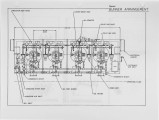| Title |
Use of Computational Fluid Dynamics Modelling to Study Fuel Burnout in a Low NOx Retrofit Application |
| Creator |
Facchiano, Anthony |
| Publisher |
University of Utah |
| Date |
1989 |
| Spatial Coverage |
presented at Short Hills, New Jersey |
| Abstract |
A commercially available computational fluid dynamics code was employed to evaluate the effects of NOx floor port design parameters on system performance for the low NOx retrofit of a field erected boiler. Design parameters considered Included floor port location and velocity. and oil atomizer orientation with regards to both spray angle and fuel mass distribution into the furnace. The subject boiler was a 200.000 Ib/hr Keeler/ Dorr-Oliver type MKBP, retrofitted with four Coen DAZ-25 burners rated at 66 MKB (HHV) per burner. All burners were located on the front wall at an elevation of five feet above the operating floor. and utilized a common windbox pressurized to 5.8 inches W.C. above furnace pressure at full load. Approximately 13 percent of combustion air was ducted from the wind box to the individual floor ports. When firing No.6 fuel oil with .35 weight percent bound Nitrogen. the combustion system was guaranteed not to exceed .3Ib/MMBTU NOx. 100 ppm(v) total combustibles. and 10 percent opacity. Excess air was specified at 7 percent at MCR. Existing inhouse correlations were utilized to predict thermal NOx as a function of furnace weighted heat release rate and fuel NOx as a function of fuel bound nitrogen content vs percent staging. Based on the resultant estimation of air staging requirements. the CFD code was employed to specify floor port parameters compatible with maximum fuel burnout and combustion efficiency. A base case three dimensional model was developed to simulate fuel/air mixing. oil droplet evaporation & resultant gaseous phase burnout. and furnace velocity & temperature profiles throughout the furnace. Sensitivity cases examined the effects of variations in NOx port design parameters on system performance. Best case modelling results were then used as the basis for the actual system design. |
| Type |
Text |
| Format |
application/pdf |
| Language |
eng |
| Rights |
This material may be protected by copyright. Permission required for use in any form. For further information please contact the American Flame Research Committee. |
| Conversion Specifications |
Original scanned with Canon EOS-1Ds Mark II, 16.7 megapixel digital camera and saved as 400 ppi uncompressed TIFF, 16 bit depth. |
| Scanning Technician |
Cliodhna Davis |
| ARK |
ark:/87278/s6668gsk |
| Setname |
uu_afrc |
| ID |
5275 |
| Reference URL |
https://collections.lib.utah.edu/ark:/87278/s6668gsk |















